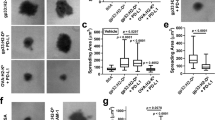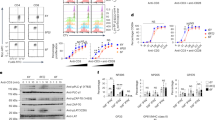Abstract
The CD8 co-receptor is important in the differentiation and selection of class I MHC-restricted T cells during thymic development, and in the activation of mature T lymphocytes in response to antigen. Here we show that soluble CD8αα receptor, despite an extremely low affinity for MHC, inhibits activation of cytotoxic lymphocytes by obstructing CD3 ζ-chain phosphorylation. We propose a model for this effect that involves interference of productive receptor multimerization at the T-cell surface. These results provide new insights into the mechanism of T-cell activation and evidence that CD8 function is exquisitely sensitive to disruption, an effect that might be exploited by molecular therapeutics.
This is a preview of subscription content, access via your institution
Access options
Subscribe to this journal
Receive 12 print issues and online access
$209.00 per year
only $17.42 per issue
Buy this article
- Purchase on Springer Link
- Instant access to full article PDF
Prices may be subject to local taxes which are calculated during checkout




Similar content being viewed by others
References
Townsend, A. & Bodmer, H. Antigen recognition by class I-restricted T lymphocytes. Annu. Rev. Immunol. 7, 601 –624 (1989).
Doherty, P.C. T cells and viral infections. Br. Med. Bull. 41, 7–14 (1985).
Tanaka, K., Yoshioka, T., Bieberich, C. & Jay, G. Role of the major histocompatibility complex class I antigens in tumor growth and metastasis. Annu. Rev. Immunol. 6, 359 –380 (1988).
Mason, D.W. & Morris, P.J. Effector mechanisms in allograft rejection. Annu. Rev. Immunol. 4, 119– 145 (1986).
Fung Leung, W.P. et al. CD8 is needed for development of cytotoxic T cells but not helper T cells. Cell 65, 443– 449 (1991).
Fung Leung, W.P. et al. CD8 is needed for positive selection but differentially required for negative selection of T cells during thymic ontogeny. Eur. J. Immunol. 23, 212–216 (1993).
Teh, H.S. et al. Participation of CD4 coreceptor molecules in T-cell repertoire selection. Nature 349, 241– 243 (1991).
Killeen, N., Moriarty, A., Teh, H.S. & Littman, D.R. Requirement for CD8-major histocompatibility complex class I interaction in positive and negative selection of developing T cells. J. Exp. Med. 176, 89–97 (1992).
Zamoyska, R. The CD8 coreceptor revisited: one chain good, two chains better. Immunity 1, 243–246 ( 1994).
Turner, J.M. et al. Interaction of the unique N-terminal region of tyrosine kinase p56lck with cytoplasmic domains of CD4 and CD8 is mediated by cysteine motifs. Cell 60, 755–765 (1990).
Van Oers, N.S. et al. Disruption of CD8-dependent negative and positive selection of thymocytes is correlated with a decreased association between CD8 and the protein tyrosine kinase, p56lck. Eur. J. Immunol. 22 , 735–743 (1992).
Anel, A., O'Rourke, A.M., Kleinfeld, A.M. & Mescher, M.F. T cell receptor and CD8-dependent tyrosine phosphorylation events in cytotoxic T lymphocytes: activation of p56lck by CD8 binding to class I protein. Eur. J. Immunol. 26, 2310–2319 (1996).
Kersh, E.N., Shaw, A.S. & Allen, P.M. Fidelity of T cell activation through multistep T cell receptor zeta phosphorylation. Science 281, 572–575 (1998).
Kwan Lim, G.E., Ong, T., Aosai, F., Stauss, H. & Zamoyska, R. Is CD8 dependence a true reflection of TCR affinity for antigen? Int. Immunol. 5, 1219– 1228 (1993).
Yoon, S.T., Dianzani, U., Bottomly, K. & Janeway, C.A., Jr. Both high and low avidity antibodies to the T cell receptor can have agonist or antagonist activity. Immunity 1, 563– 569 (1994).
Glaichenhaus, N., Shastri, N., Littman, D.R. & Turner, J.M. Requirement for association of p56lck with CD4 in antigen-specific signal transduction in T cells. Cell 64, 511– 520 (1991).
Williams, O., Vukmanovic, S. & Zamoyska, R. Phosphorylation of murine CD8 alpha is not essential for responses of T cell hybridomas to antigen. Int. Immunol. 3, 785–792 (1991).
O'Rourke, A.M. & Mescher, M.F. Cytotoxic T-lymphocyte activation involves a cascade of signalling and adhesion events. Nature 358, 253–255 ( 1992).
Chan, I.T. et al. Thymic selection of cytotoxic T cells independent of CD8 alpha-Lck association. Science 261, 1581– 1584 (1993).
Norment, A.M., Salter, R.D., Parham, P., Engelhard, V.H. & Littman, D.R. Cell-cell adhesion mediated by CD8 and MHC class I molecules. Nature 336, 79– 81 (1988).
O'Rourke, A.M., Rogers, J. & Mescher, M.F. Activated CD8 binding to class I protein mediated by the T-cell receptor results in signalling. Nature 346, 187–189 (1990).
Salter, R.D. et al. A binding site for the T-cell co-receptor CD8 on the alpha 3 domain of HLA-A2. Nature 345, 41– 46 (1990).
Connolly, J.M., Hansen, T.H., Ingold, A.L. & Potter, T.A. Recognition by CD8 on cytotoxic T lymphocytes is ablated by several substitutions in the class I alpha 3 domain: CD8 and the T-cell receptor recognize the same class I molecule. Proc. Natl. Acad. Sci. USA 87, 2137–2141 (1990).
Luescher, I.F. et al. CD8 modulation of T-cell antigen receptor-ligand interactions on living cytotoxic T lymphocytes. Nature 373, 353–356 (1995).
Garcia, K.C. et al. CD8 enhances formation of stable T-cell receptor/MHC class I molecule complexes. Nature 384, 577– 581 (1996).
Gao, G.F. et al. Crystal structure of the complex between human CD8 alpha(alpha) and HLA-A2. Nature 387, 630– 634 (1997).
Garboczi, D.N. et al. Structure of the complex between human T-cell receptor, viral peptide and HLA-A2. Nature 384, 134– 141 (1996).
Wyer, J.R. et al. T Cell Receptor and Coreceptor CD8αα Bind Peptide-MHC Independently and with Distinct Kinetics. Immunity 10, 219–225 (1999).
Jameson, S.C., Carbone, F.R. & Bevan, M.J. Clone-specific T cell receptor antagonists of major histocompatibility complex class I-restricted cytotoxic T cells. J. Exp. Med. 177, 1541–1550 (1993).
De Magistris, M.T. et al. Antigen analog-major histocompatibility complexes act as antagonists of the T cell receptor. Cell 68, 625– 634 (1992).
Price, D.A. et al. The influence of antigenic variation on cytotoxic T lymphocyte responses in HIV-1 infection. J. Mol. Med. 76, 699–708 (1998).
Sewell, A.K., Harcourt, G.C., Goulder, P.J., Price, D.A. & Phillips, R.E. Antagonism of cytotoxic T lymphocyte-mediated lysis by natural HIV-1 altered peptide ligands requires simultaneous presentation of agonist and antagonist peptides. Eur. J. Immunol. 27, 2323–2329 (1997).
Bertoletti, A. et al. Natural variants of cytotoxic epitopes are T-cell receptor antagonists for antiviral cytotoxic T cells. Nature 369, 407–410 (1994).
Klenerman, P. et al. Cytotoxic T-cell activity antagonized by naturally occurring HIV-1 Gag variants. Nature 369, 403– 407 (1994).
Allen, P.M. & Zinkernagel, R.M. Promethean viruses? Nature 369, 355–356 ( 1994).
Preckel, T., Grimm, R., Martin, S. & Weltzien, H.U. Altered hapten ligands antagonize trinitrophenyl-specific cytotoxic T cells and block internalization of hapten-specific receptors. J. Exp. Med. 185, 1803–1813 (1997).
Purbhoo, M.A. et al. Copresentation of natural HIV-1 agonist and antagonist ligands fails to induce the T cell receptor signaling cascade. Proc. Natl. Acad. Sci. USA 95, 4527–4532 (1998).
Viola, A. & Lanzavecchia, A. T cell activation determined by T cell receptor number and tunable thresholds. Science 273, 104–106 (1996).
Cerundolo, V., Tse, A.G., Salter, R.D., Parham, P. & Townsend, A. CD8 independence and specificity of cytotoxic T lymphocytes restricted by HLA-Aw68.1. Proc. R. Soc. Lond. B. Biol. Sci. 244, 169–177 (1991).
Lyons, D.S. et al. A TCR binds to antagonist ligands with lower affinities and faster dissociation rates than to agonists. Immunity 5, 53–61 (1996).
Kessler, B.M., Bassanini, P., Cerottini, J.C. & Luescher, I.F. Effects of epitope modification on T cell receptor-ligand binding and antigen recognition by seven H-2Kd-restricted cytotoxic T lymphocyte clones specific for a photoreactive peptide derivative. J. Exp. Med. 185, 629–640 (1997).
Hampl, J., Chien, Y.H. & Davis, M.M. CD4 augments the response of a T cell to agonist but not to antagonist ligands. Immunity 7, 379 –385 (1997).
Davis, M.M. et al. Ligand recognition by alphabeta T cell receptors. Annu. Rev. Immunol. 16, 523–544 (1998).
Boniface, J.J. et al. Initiation of signal transduction through the T cell receptor requires the peptide multivalent engagement of MHC ligands. Immunity 9, 459–466 ( 1998).
Choksi, S., Jameson, B.A. & Korngold, R. A structure-based approach to designing synthetic CD8alfa peptides that can inhibit cytotoxic T-lymphocyte reponses. Nature Med. 4, 309–314 ( 1998).
Giblin, P., Ledbetter, J.A. & Kavathas, P. A secreted form of the human lymphocyte cell surface molecule CD8 arises from alternative splicing. Proc. Natl. Acad. Sci. USA 86, 998–1002 ( 1989).
Ho, A.D. et al. Plasma levels of soluble CD8 antigen and interleukin-2 receptor antigen in patients with hairy cell leukemia, relationship with splenectomy and with clinical response to therapy. Leukemia 3, 718–723 (1989).
Zielinski, C.C., Pesau, B. & Muller, C. Soluble interleukin-2 receptor and soluble CD8 antigen in active rheumatoid arthritis. Clin. Immunol. Immunopathol. 57, 74–82 (1990).
Maimone, D. & Reder, A.T. Soluble CD8 levels in the CSF and serum of patients with multiple sclerosis. Neurology 41, 851–854 (1991).
Linker Israeli, M. et al. Elevated in vivo and in vitro secretion of CD8-alpha molecules in patients with systemic lupus erythematosus. J. Immunol. 152, 3158–3167 (1994).
Agostini, C. et al. Increased levels of soluble CD8 molecule in the serum of patients with acquired immunodeficiency syndrome (AIDS) and AIDS-related disorders. Clin. Immunol. Immunopathol. 50, 146– 153 (1989).
Reinherz, E.L. & Schlossman, S.F. The differentiation and function of human T lymphocytes. Cell 19, 821–827 (1980).
Price, D.A. et al. Antigen specific release of beta-chemokines by anti-HIV1 cytotoxic T lymphocytes. Curr. Biol. 8, 355– 358 (1998).
Cobbold, S.P., Qin, S., Leong, L.Y., Martin, G. & Waldmann, H. Reprogramming the immune system for peripheral tolerance with CD4 and CD8 monoclonal antibodies. Immunol. Rev. 129, 165–201 (1992).
Acknowledgements
We thank A. van der Merwe, B. Willcox and J. Wyer for sharing unpublished results; S. Davis and C. O'Callaghan for suggestions and critical review; R. Tan for the gift of clone 10; and P. Easterbrook, B. Gazzard and P. Giangrande for providing patient samples. This work was supported by the Wellcome Trust and the Medical Research Council.
Author information
Authors and Affiliations
Corresponding author
Rights and permissions
About this article
Cite this article
Sewell, A., Gerth, U., Price, D. et al. Antagonism of cytotoxic T-lymphocyte activation by soluble CD8. Nat Med 5, 399–404 (1999). https://doi.org/10.1038/7398
Received:
Accepted:
Issue Date:
DOI: https://doi.org/10.1038/7398
This article is cited by
-
Low on-treatment levels of serum soluble CD8 (sCD8) predict better outcomes in advanced non-small cell lung cancer patients treated with atezolizumab
Cancer Immunology, Immunotherapy (2023)
-
The light and dark sides of intestinal intraepithelial lymphocytes
Nature Reviews Immunology (2011)
-
High affinity soluble ILT2 receptor: a potent inhibitor of CD8+ T cell activation
Protein & Cell (2010)



